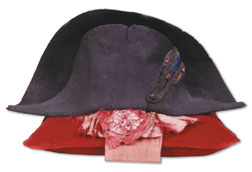The Legend – Napoléon Lives On
Napoléon was conscious of the impression he made and sought to control his image from the earliest days of his career until his imprisonment on St. Helena. A master of propaganda, he presented himself as a humble soldier and as royalty cloaked in ermines and jewels, depending upon his intentions. He burnished his image even further while at St. Helena, dictating his memoirs and at times, tailoring history to his advantage. His legend was beginning to take flight by then, and Napoléon read with interest of himself in materials about him that would make their way to his island exile.
Countless books and articles have delved into his story since his death, each author seeking to explain what sort of man believes he can change the world. The resulting portrait is complex and contradictory. The figure who emerges is a keen judge of character, who somehow trusted disloyal and double-crossing colleagues. A husband who deeply loved his wife but divorced her when she failed to produce an heir. A general who felt intensely about his soldiers, yet sacrificed hundreds of thousands of them during his military career, and although fearless, abandoned his men when he felt it expedient. A brilliant administrator who did everything he could to strengthen the French nation, while embroiling her in two decades of constant warfare. Endlessly fascinating, the true nature of Napoléon’s character will be debated for centuries. Triumphant and tragic, his life captured the full breadth of human emotion, and his story rarely fails to evoke strong emotions in the telling, be they admiration or contempt or both.
Image:
The Emperor’s Hat, summer model seen with Napoléon’s Legion of Honour Sash
Poupard Chapelier - c. 1805
There is no greater icon of the Napoléon legend than his hat. This one was worn in the 1809 Battle of Essling. He preferred the design “broadside on,” the sides parallel with his shoulders, so that in battle, he could be distinguished from his officers, who wore their hats “fore-and-aft.” The style and shape of his famous hat changed with the times, and the size was not always the same. Several examples, both summer and winter weight, have survived.
Historical Provenance - General Mouton collection
Felt